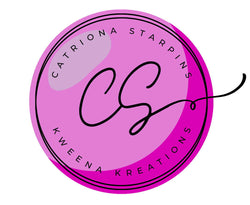Finishing the Bead Challenge Pendant, Building a DRAW Rope and Adding the Final Touches
It’s been a few weeks since I last worked on this pendant, and it feels great to be back at the bead table! In this session, I’m taking you through how I incorporated some sparkling bicones and two-hole cabochons into my design, building up the rope using Double Right Angle Weave (DRAW) and adding those all-important finishing details.
Building the DRAW Rope
To start, I worked one full unit of DRAW, combining the structure of right-angle weave with some embellishment beads for extra texture. For each unit, I began with a circle of four seed beads, reinforcing the thread path to keep the tension even.
From there, I added an embellishment bead between each of the base beads, it’s a small touch that really brings the structure to life. Next came the 6mm bicone crystals, which add sparkle and weight but can be a little sharp, so I always double my thread passes for durability.
Then, I added a two-hole cabochon to the side of the unit, surrounding it with size 11 seed beads. This gave the component a lovely, raised effect, almost like a tiny starburst around the cabochon.
Creating the Repeating Units
Once the first few units were complete, it was time to make the smaller DRAW components that form the back section of the necklace. For my length, I needed ten of these smaller DRAW units to sit comfortably around the back of my neck, and three larger ones featuring the cabochons to form the front focal area.
Each of these units connects with neat little square-stitched beads, keeping the spacing consistent and allowing the rope to move beautifully when worn.
Choosing and Adding the Clasp
Ah, the eternal question, what clasp should I use?
I tried out a few different options, including a vintage-style hook and eye and a few decorative box clasps. In the end, I went with a simple pewter-coloured box clasp that complements the centrepiece perfectly. It’s subtle, secure, and comfortable, everything you want in a clasp.
Even though I originally planned to make a beaded clasp to match, this one struck the right balance between practicality and design harmony. The pewter tone echoes the metal accents in the pendant, tying the whole piece together.
The Final Connection
Attaching the rope to the pendant is one of the trickiest, but most satisfying steps. I carefully stitched the ends of the DRAW rope into the sides of the pendant, using multiple thread paths for strength without overfilling the beads.
Because the pendant has some weight, I made sure the connection also passed through the foundation backing of the bead embroidery. This provides extra security so the piece can be worn confidently without risk of strain.
Testing the Fit
Once the rope was attached, I tested how it sat both on my mannequin and on myself. Comfort is so important, especially when you’ve invested hours into your beadwork! The bicones, while firm in structure, don’t rub against the neck, and the overall length sits just where I want it.
If you’re working on your own bead challenge piece, this stage is essential. Try it on, check the proportions, and make sure the finishing details are as considered as the focal design. Remember judges (and wearers!) will always notice neat clasps, secure threads, and thoughtful finishing.
A Few Final Thoughts
Finishing a big beading project can feel like the hardest part, especially if you’re short on time or eager to see it complete. But give yourself the space to do it properly reinforce your joins, tidy your threads, and make sure your findings are aligned and secure.
In the end, it’s these careful final touches that lift your beadwork from “beautiful” to professional and prize-worthy.
If you enjoyed following along with this project, don’t forget to like, comment, and subscribe on my YouTube channel, where I share tutorials, behind-the-scenes progress, and tips for creating beadwork you’ll be proud to wear.
Watch the by clicking on the video here:


